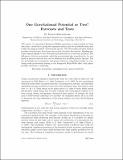One Gravitational Potential or Two? Forecasts and Tests
Author(s)
Bertschinger, Edmund
Downloadbertschinger.pdf (351.5Kb)
OPEN_ACCESS_POLICY
Open Access Policy
Creative Commons Attribution-Noncommercial-Share Alike
Terms of use
Metadata
Show full item recordAbstract
The metric of a perturbed Robertson–Walker space–time is characterized by three functions: a scale-factor giving the expansion history and two potentials that generalize the single potential of Newtonian gravity. The Newtonian potential induces peculiar velocities and, from these, the growth of matter fluctuations. Massless particles respond equally to the Newtonian potential and to a curvature potential. The difference of the two potentials, called the gravitational slip, is predicted to be very small in general relativity, but can be substantial in modified gravity theories. The two potentials can be measured, and gravity tested on cosmological scales, by combining weak gravitational lensing or the integrated Sachs–Wolfe effect with galaxy peculiar velocities or clustering.
Date issued
2011-12Department
Massachusetts Institute of Technology. Department of Physics; MIT Kavli Institute for Astrophysics and Space ResearchJournal
Philosophical Transactions of The Royal Society A Mathematical Physical and Engineering Sciences
Publisher
Royal Society, The
Citation
Bertschinger, E. “One gravitational potential or two? Forecasts and tests.” Philosophical Transactions of the Royal Society A: Mathematical, Physical and Engineering Sciences 369.1957 (2011): 4947-4961.
Version: Author's final manuscript
ISSN
1364-503X
1471-2962